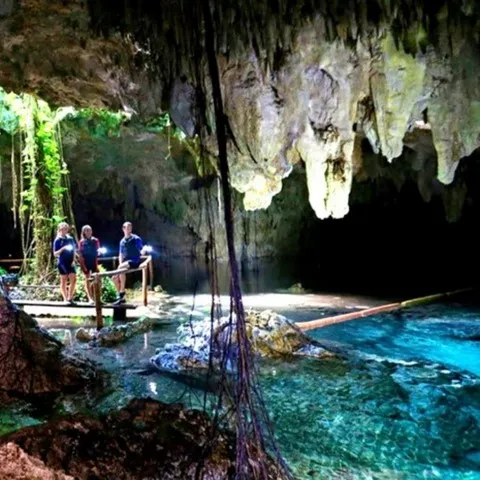Swim in a cenote ...
October 19, 2022
swim in the heart of a cenote ...

Cenotes in Playa del Carmen offer an unparalleled experience of swimming and exploring crystal-clear waters. From young families with children exploring the shallows to professional divers diving into the depths, swimming in the cenotes is a once-in-a-lifetime adventure that shouldn't be missed. Find out all the information you need to know about prices, schedules, and activities for visiting the best cenotes in Playa del Carmen.
Cenotes are natural water wells. You will find thousands of them all over the Yucatan Péninsula Peninsula. The ancient Maya recognized them as the gateway to the Xibalba, the world of the dead.
In addition, cenotes are popular tourist attractions because they offer a unique experience. Cenotes are usually accessible via a diving or snorkeling expedition. Before diving into a cenote, swimmers should check the temperature, depth and visibility of the water to avoid injury. In addition, some cenotes have an underground stream that attracts cave fish and other animals such as catfish and worms.
While swimming in a cenote, visitors can also enjoy the Mexican landscape from an underwater vantage point. The clear blue waters provide an ideal swimming environment during the warmer seasons as there is little to no visibility underwater due to the accumulation of silt on the bottom of most cenotes.
Cenotes are natural water wells. You will find thousands of them all over the Yucatan Péninsula Peninsula. The ancient Maya recognized them as the gateway to the Xibalba, the world of the dead.
- Now, hundreds of cenotes are set up to safely receive visitors who come to swim and snorkel in their clear waters.
- A must-see cenote in Playa del Carmen is the underground cenote Chaak Tun (only 10 minutes from the center), whose 2.5 hour guided tour allows you to snorkel while exploring several beautiful caves.
- Another interesting option is to go to Chikin Ha, which allows you to discover both a cenote in a cave, swim in the clear water of an open cenote and go zip-lining in the jungle.
The pleasure of swimming in a Mexican cenote
The word cenote means cave in Spanish and comes from the Mayan language. Cenotes can be found in many parts of Mexico, including the Yucatan Peninsula, Lake Chapala, Xochimilco and the Biosphere Reserves.
In addition, cenotes are popular tourist attractions because they offer a unique experience. Cenotes are usually accessible via a diving or snorkeling expedition. Before diving into a cenote, swimmers should check the temperature, depth and visibility of the water to avoid injury. In addition, some cenotes have an underground stream that attracts cave fish and other animals such as catfish and worms.
The cenotes, these natural reservoirs of appreciated freshness
Generally located in limestone areas, cenotes have steep entrances with no depth markers. Some cenotes also have chambers with stalactites, stalagmites and other formations inside. Therefore, swimmers should be aware of their surroundings when diving in a cenote as there is always a chance of coming across something unexpected.
- After descending into the water, swimmers can enjoy the cool water. While swimming in a cenote, visitors can also observe local divers diving in the deepest parts to collect gems or artifacts from past generations. In addition, the caves are excellent places for cliff climbing as there is no vegetation around the edges of the cliffs that could snag the climbers' clothes or hair while climbing.
While swimming in a cenote, visitors can also enjoy the Mexican landscape from an underwater vantage point. The clear blue waters provide an ideal swimming environment during the warmer seasons as there is little to no visibility underwater due to the accumulation of silt on the bottom of most cenotes.
- Some swimmers have even reported seeing live bats while swimming in some Mexican cenotes due to the low penetration of sunlight underwater, a rare experience under normal circumstances. Despite the dangers associated with swimming in some Mexican cenotes, such as strong currents, the experience is still worthwhile due to the cool temperatures and refreshing waters at the bottom of these tanks.
From what can be observed when visiting different Mexican cenotes, it seems that there is potential for both fun and study in aquatic conditions when diving in these tanks. However, swimmers should always do their research before entering a body of water, as the conditions at a given site may not be what they expect!
The lasting memory of a dive in one of these magical places !